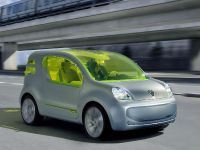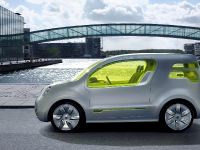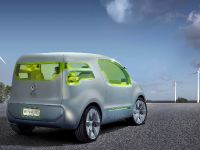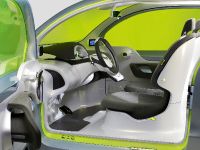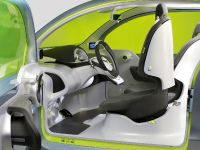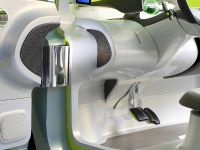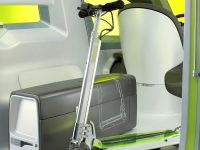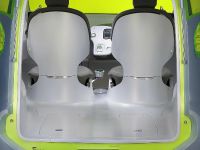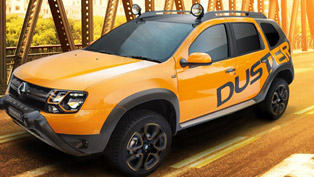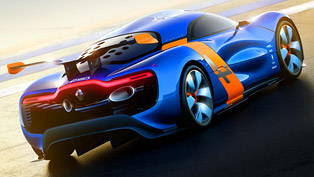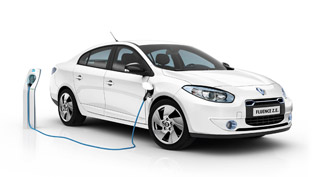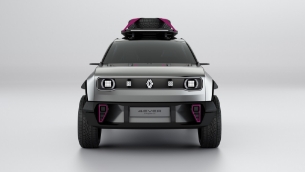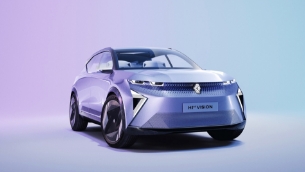Renault Z.E. concept, an all-electric concept car which provides a glimpse of mobility in the future
Alongside its new TCe and dCi engine ranges, Renault is furthering its strategy aimed at reducing CO2 emissions with the development of electric vehicles. Since the beginning of 2008, the Renault-Nissan Alliance has signed agreements with several states and regions ( Israel , Denmark , Portugal , Japan 's Kanagawa prefecture, the state of Tennessee in the USA ), which will lead to the mass marketing of this form of vehicle from 2011.
Z.E. Concept ('Z.E.': Zero Emission) is Renault's vision of the electric vehicle as an efficient, user-friendly, zero-emission car. Based on the brand new Renault Kangoo be bop, Z.E. Concept features a fun design which has been adapted to the spirit of an electric vehicle, with the focus on minimising energy consumption while at the same time providing core comfort features.
The energy consumption of auxiliary functions such as lighting, heating, climate control, etc. is an electric vehicle's range, so special attention has been paid to optimise energy management. Z.E. Concept also incorporates several interactive information features which are fun to use.
Z.E. Concept is powered by a 70kW electric motor with torque of 226Nm, with lithium-ion batteries.
Energy saving management at the heart of Z.E. Concept's design
Z.E. Concept is based on Kangoo be bop and its compact dimensions (length: 3.95m, height: 1.85m) favour manoeuvrability in and about town. The design of this electric vehicle ensures that it is fun to ride in, but at the same time minimises energy consumption, without forgetting modern comfort-related refinements.
The use of heat-reflective paint and insulating bodywork featuring large surface areas contributes to the reduction of temperature fluctuations. Traditionally this prompts the use of climate control or heating systems which are big consumers of energy. Insulation is further optimised by the use of acid green-tinted glass for the glazed areas.
The bodywork functions along the same lines as a Thermos flask. It comprises two insulating panels with a sandwich of air. This air, which is still the most effective insulator known today, limits variations in temperature between the exterior and the interior of the car.
Solar panels, positioned on the roof, power a temperature regulation system. Cooling the inside of a vehicle uses a great deal of energy, but this system permits a pleasant temperature to be maintained in the cabin, even at standstill or when parking, and avoids having to switch on the climate control when starting the vehicle.
Meanwhile, the layout of the heating and climate control functions has been thought through to produce a particularly efficient balance between performance and energy consumption. For example, the impression of heat is especially felt on the face and hands. Accordingly, if the cabin temperature is 15°C but warmth can be channelled as close as possible to key zones (a heated steering wheel, for example), the driver will feel comfortable while using less electrical energy.
The conventional drag-producing exterior mirrors have been replaced by streamlined, low-energy cameras which are also powered by the roof-mounted solar panels to enhance all-round visibility, especially when manoeuvring. The low-drag full-disc aluminium alloy wheels also improve aerodynamic performance.
The headlamps use efficient, high-performance light-emitting diodes (LEDs) which are not only long lasting but also low consumers of energy.
Optimising energy management is consequently a key aspect of the research that has gone into the technology employed for this concept car.
An interactive, user-friendly vehicle
The Z.E. Concept offers motorists and passengers a pleasant, relaxing ride and this sensation is enhanced by a number of interactive communication features. For example, logos light up to signal that the vehicle recognises its occupants as they approach.
Z.E. Concept illustrates Renault's vision of mobility in the future. As a socially responsible vehicle, it is equipped with polyurethane gel bumpers, for example. These deform easily to soak up minor knocks, while pedestrians are reassured by their absorbent aspect.
A linear display on the outside of the door provides a visual indication of how much range remains even before the driver gets into the vehicle. This display is reminiscent of a mobile phone charge-indicator.
As a vehicle of the future, Z.E. Concept is seen as a simple link in the overall mobility chain. To facilitate getting around in areas where space is a premium, an electric scooter is packed into the boot and is charged via the car's own system. To make loading easier, the rear hatch-type tailgate combines with a wide, folding sill which enables this scooter – or any other item – to be slid into the boot.
Z.E. Concept contains very few fluids that need recycling at the end of its lifecycle.
The smart navigation interfaces feature an innovative approach to alleviating the vehicle's energy requirements. Indeed, electricity can be saved by making journeys easier. The MMIs (Man Machine Interfaces) are able to pinpoint the nearest car parks equipped with charging stations as a function of the remaining range, making Z.E. Concept a car which not only warns and calculates, but which also thinks ahead. Information is relayed from the vehicle to the driver and vice-versa via a mobile phone which connects directly to the dashboard.
A mobile phone-based navigation system is used which avoids the necessity for an energy-consuming onboard computer. The dashboard itself takes the form of two distinct functional units:
- a new-format minimalist display which provides specific data relating to the electric motor,
- a remotely-positioned control between the seats incorporating a touchpad to enter data.
All-electric power, zero emissions
Z.E. Concept is equipped with a 70kW (95hp) electric motor which delivers torque of 226Nm, making it particularly flexible, responsive and comfortable to use. Batteries are lithium-ion type.
Z.E. Concept provides a preview of the Renault electric vehicle which will be easy to use, practical and efficient.
Dimensions
| Length (mm) |
3,945 |
| Width (mm) |
1,856 |
| Height (mm) |
1,748 |
| Height with tailgate open (mm) |
1,902 |
| Wheelbase (mm) |
2,406 |
| Front track (mm) |
1,572 |
| Rear track (mm) |
1,572 |
| Front overhang (mm) |
794 |
| Rear overhang (mm) |
745 |
| Unlade weight (kg) |
1,520 |
Technical data
| Power source | Electric motor |
| Power output | Peak output: 70kW (95hp). Continuous output: 50kW |
| Maximum torque | 226Nm |
| Battery type | Lithium-ion |
| Transmission | Direct with front/rear reducer and inverter |
| Traction | Electric |
| Tyres | 245/35R21 |
| Wheels | Diameter: 21"/Width: 8.5" |
Partners
| D 3 | Bodywork |
| Michelin | Pilot Sport PS2 tyres |
| Samsung | Samsung F480 cell phone for communication with the vehicle |
